Welcome to the new Traders Laboratory! Please bear with us as we finish the migration over the next few days. If you find any issues, want to leave feedback, get in touch with us, or offer suggestions please post to the Support forum here.

The Pip Thief
-
Content Count
40 -
Joined
-
Last visited
Posts posted by The Pip Thief
-
-
can you post a video?Yes, what do you want to see? Why are the pics not clear? I will post one on Monday just tell me what you want to see. I am moving this weekend and I want the market to be open cause its cooler.
The Pip Thief
-
are you associated with PositionSizer.com ?No, Just a happy client and improved trader. I found positonsizer by typing surinotes into google.
The Pip Thief
-
I seem to recall you posted pictures of MTPredictor in the past? Do you now prefer to use the PositionSizer.com software?They again are not the same thing at all. I know of them but they are not an order entry software. I am not understand how you do not see the difference. It is kind of a startling difference I might ad.
I click on screen on my entry price, my stop price, then 0, 1, or 2 profit targets them my position is sized and I hit the trade position button. Then a bracket order is sent to my broker and then the entry order is filled and the stop and profit target(s) are place automatically.
If I have the AUTO ATR set to on the my stop is automatically moved at IB as the trade goes in my direction. Maybe I was not clear.
The Pip Thief.
-
I think quite possibly Pipthief has stripped out some useful components of MTP, i.e. the position sizing and ATR components, and is now selling them as stand alone script. For the $800, you would be better spending the extra vig and get MTPredictor and its EW and fib capabilities. Afterall, the position size calculator is easy to program, and the ATR stop is available for almost all charting platforms for free.I suspect that Pipthief's posts are a subtle form of spam. I may be wrong, but that i show it looks to me.
Best Wishes,
Thales
Hi Thales,
I respect your comment but get your facts straight.
1. PositionSizer is an order entry software. You click through the series of prices and your position is sized and then you click TRADE POSITION and the order (MKT-LMT-STPLMT-STP) is sent to your broker. So that means you get sized and the order enter with BRACKETS to the broker in less than 4 seconds.
2. Your balance auto feeds so no need to do this, Can someone tell me if MTP does this actually so I do not sound ignorant?
3. There is a Tick Data Base.
4. There is a live currency feed. Does MTP do this? Again some one answer that for me please?
AUTOMATIC ATR manages the trade's stop at the broker and then closes position when it is touched.
PositionSizer is an order entry software that works with the API of banks to enter your order with the broker right after it is sized through the trade position button.
There are lots of cool features or at least I think so but this is not a buy and sell signal program at all.
I am a price action trader and do not have a system. I just use patterns. MTP did not invent the ABC pattern or Position Sizing. I learned the patterns from Suri Duddella's book which is quite nifty I might ad.
The Pip Thief
-
I seem to recall you posted pictures of MTPredictor in the past? Do you now prefer to use the PositionSizer.com software?No not at all. Never Posted a single trade from MTP and do not even own it.
The Pip Thief
-
I love seeing your entries! Any guidelines you follow for your IB or ABC patterns??Thanks Daedalus! I actually stopped posting because the thread was me talking to myself there for a while and nobody wants to hear someone babbling on about themselves. So it does give me pleasure to hear your kind words.
As for my set-ups. The most important aspect of them all is that I look for low range bars to enter so I can buy more contracts or money in the method IB(Interactive Brokers) takes their orders. With IB they want the $ amount and not the lot quantity. This means that you can enter any size $ value in increments of $1000 as long as the order is over $25,000. This allows you to size right up to your actual % Risk.
As for the actual set-up I am just looking for the ABC in the swing chart and then if at the top of the swing I get a low range bar then I am in heaven. Why? Because I can buy a lot of money on the low range bars. I can use a tight stop and if the bar breaks in the right direction I am sized and in within seconds. Pretty basic but the profits are all in the way I size the position. I have done a lot of math on sizing models and tight stops rule because you will get on those 10 to 15 pounders once in a while. Risking 1% and getting back 15% is a great feeling even if it only happens rarely.
Look at the charts I have attached and you will see why even if I get stopped out with the tight stops it is better than using a large stop of 20 to 30 pips which many traders use. Or a Fixed $ amount. It is Friday so I am going to do a short post for you. Check out the 2 ABC's from yesterday and then the one we had today as well but I did not post the pic. You can almost always find these and even several per day. The key to making big money on them is the right sizing.
The Pip Thief
-
also the original writer of the quoted link can be found..... I think he has a very good website/blog providing some good info. Particularly in this case the info about the sequence of trade wins v losses and how it can relate to position sizing.Very Interesting indeed. Did you see how when you change the trade sequence that Fixed Ratio is better in first example and then in the second example Fixed Fractional is much better? In reality the best strategy would be to start a small account with Fixed Ratio and then go to Fixed Fractional as it grows. Again this does depend on distribution and the only way to find out how to trade your system best is to do 10,000 simulations of 100 or 1000 trades and to see what would have been best.
I must admit that I am too addicted to % risk and prefer my model for the stage that I am presently. Good article though and just goes to show you how Numbers can play games on results depending on all the variables. I would not say I am a believer but I definitely give merit to the Fixed Ratio at this point which is something I would not have done previously.
So thank you to all who reasoned me through this mental process.
The Pip Thief
-
DUGDUG,
I see what you mean. Your are 100% Right about the psychology side side. All to often traders lose in not on the losing side but on the winning side. Had a friend do this actually. These ups in trading can be deadly.
Sorry, you wording did throw me off and I guess I was quick to shoot without proper examination of your remarks as I was just thinking of the math and not the psychology of the equation. If you head is not right then none of these strategies work. That is for sure so I am right on with you there. Thanks for the clarification. I guess I am the one who was letting something fly over my head, which happens quite often if I am honest.

The Pip Thief
-
Given both of these points then shouldn't most new traders use the fixed ratio method - as it grows the number of contracts they trade more slowly?Hence they are are aiming to be more consistently profitable rather than just trying to trade larger size more quickly.
given the example quoted on the link, then if after only 24 trades, a new trader is trading 13 contracts, then the stress of any big loss could be devastating.....most new traders are still thinking in absolute dollar terms not percentages
This assumes that they have enough capital to actually trade most products (if you have only enough to cover the margins then you are undercapitalised) , and that you already have a strategy that works.
Not to argue as I do agree the % method is the best....just that for a new trader looking to increase the position size - the fixed ratio is a slower method of doing it hence somewhat more conservative. Easier to understand and implement.
Of course if going for scale scale scale with absolute returns combined with capital preservation, then % rules the roost.
This is going over you head I think because it does not matter the number of contracts you trade. You are missing the point of % Risk Modeling. They are risking 1 % . How can it be stressful risking 1% I ask you, You need lose 20 straight to be down 20% I will take those odds any day.
What I am finding is Fixed Ration dwells on contracts and this is not good versus % Risk dwells on the % you risk and not the # of contracts.
Plus being up 90% after only 24 trades would give me enough confidence to trade this system.
The Pip Thief
-
This can really not be answered based on the information provided. This depends on your starting capital and the delta being used. Read this article for a fairly painless explanation and you should have a better idea how it works: Fixed RatioSorry but you are not answering a question that could be answered. After much reading and research of your strategy, I just wanted to tell you that from the information I gave you you can answer my question with hypothetical responses.
1. You could say that if this was your starting balance then you would trade one contract and calculate your delta and then increase by on contract every time your balance adds a delta. Like if 4000 was the delta then I would trade 2 contracts at $74,000.
2. If my starting balance was 50,000 and I had the same $4000 delta then I would be trading 5 contracts at the $70,000 mark.
Wow that was easy! I know more about your strategy than you already.
Plus it is funny how you gave me a link trying to prove you were right and it proved you wrong:rofl:
After 24 trades on the link you gave me we are only up $55,268 in equity and trading 2 contracts with a starting capital of $50,000.
Now on that page there is a link to my method with the results. MATH Results that you had to see or you would not believe. I put the link in below. This is the # Risk Model crushing your results. These were the same sample of trades by the way.
Fixed Fractional Position Sizing Another Name for % Risk Model
Now our equity with the same trades is at $91,887 after 24 trades and we are trading 13 contracts with the same $50,000 starting capital.
So your model made 10% and % Risk Model made 90% after 24 trades. WTF!!! If it was a difference of 10% then yes I would still say maybe there is a chance your model is better than % Risk. But the numbers are lopsided. There are your numbers my friend, ironically found on the site you turned me on too. Now if you come back and argue now it is just a case of ignorance.
The Pip Thief
-
This can really not be answered based on the information provided. This depends on your starting capital and the delta being used. Read this article for a fairly painless explanation and you should have a better idea how it works: Fixed RatioSo I am understanding that this starts off trading 1 contract. Even if you balance can handle more? This does not make sense. What if I have a million and and a Delta of $10,000 then I start trading one contract and when I have 1,010,000 then I would start trading 2 contracts?
Am I understanding this correctly?
"Because the number of contracts always starts at one, the fixed ratio method usually produces better results for smaller accounts. For larger accounts, it may take an unreasonable amount of time to increase the number of contracts to a level that takes full advantage of the available equity."
This is not a strategy that is interesting at all for larger traders. I must point out that the flexibility is proven better with % Risk Model. If you take any field actually, not trading, including census studies, disease control, migration or crime stats. All of these are put into percentages because it is naturally easy to compare fields of data that may not have the same sample size and allow us to make comparisons. To say that that 30,000 people have x problems means nothing really when you break it down.
Is that 30,000 out of 300,000,000 or out or 35,000 which are completely different statistics.
The % Risk Model allows you to risk 1% of your capital in Stocks, Futures, and FOREX and be able to compare the losses with a quantifiable way. One next to another. You may also say I average winning 3 percent for every one risked in Stocks but 5 percent for every one percent risked in FOREX so I am going to put more of my equity into FOREX because I have a better return.
I have read that article and you can keep you method and I will keep mine.
We will agree to disagree:crap:
The Pip Thief
-
Actually, so I can learn something here as well. Can some one please size up the position that I have posted above and have attached here as well.
This is a short trade.
The entry price is 1.6239'5
The stop price is 1.6249'5
Tell me how large your position would be with a $70,000 account. How would you size your position? I am asking this to learn because I really do not understand this fixed ratio position size model.
Now after you are sized and you exit at 1.6136'9 how much did you make?
I would appreciate if anyone could give me a serious answer.
Thanks
The Pip Thief
-
Below I have listed the streak odds for 50% win rate up to 15 straight losses. The gambler’s fallacy is that the longer your losing streak the better your odds of winning on the next trade. Of course this is not true because each trade is statistically independent. So here are the odds without emotion or error.
2 Losses in a row = 1/(2*2)=1 out of 4 or 25% or 250 times in 1000
3 Losses in a row = 1/(4*2)=1 out of 8 or 12.5% or 125 times in 1000
4 Losses in a row = 1/(8*2)=1 out of 16 or 6.25% or 62.5 times in 1000
5 Losses in a row = 1/(16*2)=1 out of 32 or 3.125% or 31.25 times in 1000
6 Losses in a row = 1/(32*2)=1 out of 64 or 1.5625% or 15.625 times in 1000
7 Losses in a row = 1/(64*2)=1 out of 128 or .78125% or 7.8125 times in 1000
8 Losses in a row = 1/(128*2)=1out of 256 or .390625% or 3.90625 times in 1000
9 Losses in a row = 1/(256*2)=1 out of 512 or .1953125% or 1.953125 times in 1000
10 Losses in a row = 1/(512*2)=1 out of 1024 or .09765625% or .9765625 times in 1000
11 Losses in a row = 1/(1024*2)=1 out of 2048 or .048828125% or .48828125 times in 1000
12 Losses in a row = 1/(2048*2)=1 out of 4096 or .0244140625% or .244140625 times in 1000
13 Losses in a row = 1/(4096*2)=1 out of 8192 or .01220703125% or .1220703125 times in 1000
14 Losses in a row = 1/(8192*2)=1 out of 16384 or .006103515625% or .06103515625 times in 1000
15 Losses in a row = 1/(16384*2)=1 out of 32768 or .0030517578125% or .030517578125 times in 1000
My win rate is in the high 40's and this is why I bet 1% per trade. You are exactly right KIWI. You have done your homework. 1000 trades a year and you will normally have a streak of at least 10 losses in a row which is something most traders could not handle and when you risk to much you are dust in the wind.
The Pip Thief
-
While I fully agree that position sizing is important, your references above just mentioned that the traders attribute position sizing to their success. Not specifically % Risk Model of Position Sizing and what you present is hardly proof.Ryan Jones claims in his book that fixed ratio is the best. I'm sure some successful traders use his model. Does this prove that his is the best?
As I said, I agree position sizing is important, but I don't think you can claim one method is proven to be the best without actual proof. Maybe it is and I would love to see prove for that. A couple of random traders saying it is so, however is not prove.
I can show you 100's of pictures that vendors use to show how great their systems are. Posting a picture in hindsight to support your arguement, unfortunately is not prove either.
I do not know? Van Tharp is the Grand Father of PositionSizing through inheritance of Seykota. He profiled over 5000 and then proved the MATH in his book "Definitive Guide to Position Sizing" that % Risk Model is the most statistically viable via the samples he puts forth in the book. We could argue this for hours but I guess I choose % risk because it is way easier as well.
As to hindsite. That is kind of funny because we are not looking for points of entry in time but how to size market moves. They are completely not correlated in this sense. Take that same move with a one lot position or with a stop of 30 pips. What does that give you for a ROI in this trade?
You are missing the point! Again there are no rights or wrongs here so I am just giving you my standpoint as to what I think is best for a simple mine like mine.
The Pip Thief
-
Ed Sekoyta on Risk Risk worth a read.Pip Thief, Interesting you mention Williams and the Robbins World Cup. Didn't he have a close to 70% draw down in the competition? An abject lesson in how not to manage risk. To win competitions you need to throw risk management (and caution) to the wind. Maximum leverage in the most volatile instrument you can find is the position sizing rule for competitions.
You have to know what you want to do. That is my whole point. % Risk Model allow you to go into competitions or trade conservatively, use scaling or not, play with the markets money or be conservative. Reduce risk or increase risk.
Larry Williams was already a very huge investor when he threw 10 grand into the account to try and win this competition. Fixed Ratio is very complex but that is just my tiny little brain that has a hard time applying it.
The Pip Thief
-
My argument would be"why scale up" in the first place?To clarify. My definition of scaling up is adding to a trade that you are already in. I guess I was not clear. Although I have done this it scares me too much even if I am using proper or sound rules. Just my personality. I should have said that PositionSizer makes it very easy to do by not breaking some of the cardinal rules of scaling, even so I get too scared. And yes. WHY? 10% in a short time is great!
What I do much much more is play with the markets money. That is what I find to be really beneficial. The definition of this to win a big trade and then risk a little more on the second. Like if you win 10% ( which rarely happens I might add) then I risk 3% on my next trade. If I hit for 6% then I risk 2 on the next trade. This is what I call Playing with the Markets Money and % Risk Models make this easy.
One last clarification, I do not only risk 1% per day but per trade. And I would not consider this an argument but a discussion and there are no rights or wrongs!
The Pip Thief
-
Mind to expand who these top traders are and where and how they have proven this to be the best?Hello Sevensa,
No worries! I would be glad too do that for you.
Ed Seykota-
He is best known for making over 250,000% in less than 20 years not counting withdrawals. Those are absolutely staggering numbers by any stand point. Quote was taken from “Definitive Guide to Position Sizing” by Dr. Van Tharp.
"First, I'd like to acknowledge Ed Seykota who first taught me the importance of position sizing, saying that success was 60% psychology, 30% position sizing, and 10% systems. Ed was also the person who taught me the value of using the market's money." – Dr. Van Tharp
Now Dr. Van Tharp has studied the profile of over 5,000 successful traders and has come to the conclusion that the # 1 determining factor in ones trading success is how they implement % Risk Position Size Models into their trading plan.
What it comes down to is that this system is not nearly as important as people think when they come into the trading business. It’s all about how you are sized and control your risk per trade.
By the way, Van Tharp invented the word "Position Sizing" after studying all these top traders.
Larry Williams-
He is an all-time great trader and educator. The statement below says it all.
"I'm probably best known for winning the Robbins World Cup Trading Championship, turning $10,000 into $1,100,000.00 in 12 months. That was real money, real trades, and real time performance. For years people have asked for my trades to figure out how I did it. I gladly oblige them, they will learn little there - what created the gargantuan gain was not great trading ability nearly as much as the very aggressive form of money management I used. The approach was to buy more contracts when I had more equity in my account, cut back when I had less. That's what made the cool million smackers - not some great trading skill." - Larry Williams
Anyone that makes turns 10 grand into 1.1 in a year has specialized knowledge that most traders do not know. He leads to the definition but does not give the exact diagram. After more study of this great trader he admits he uses % Risk Position Size Model. His secret is the money management and not the system, these top traders set themselves apart through this approach.
Michael Marcus-
Over a ten year period he multiplied his company account by an incredible 2,500%
Michael turned $30,000 into 80 million in less than 10 years.
All of these traders and others if you want me to quote some more give credit to % Risk Model of Position Sizing to be the number on factor in their success.
I mean you have to ask yourself. Pretty much every trader out there has access to the same buy and sell systems. How the hell are a couple of these traders turning 30,000 into 80 million in less than 10 years or 10,000 into a over a 1.1 million in a year. This is what I wanted to know and I found it. It is the % Risk Model of Position Sizing. I mean there are times when I have taken a trade of 1% risk and then made 10% in an hour. Then I started to understand.
The % Risk Model is the best! It lets you scale in or out and also lets you play with the markets money. What do you do when you are day trading and make 10% in an hour. Me, I risk 3% on the next trade and if I lose I quit for the day. If I win, and normally I would have won 3% when risking 1%, by risking 3% I now won 9%. This is what I have learned from these guys who multiply their money at these alarming rates.
Hope this helps. Check out the pic if you think you cannot with 10% in an hour by only risking 1%.
The Pip Thief
-
Hello,
It is not me saying this but it is proven by all the top traders of the world that the % Risk Model of Position Size Theory is the best. You should be risking a percent of your balance.
Example - Balance 100,000 and you risk 1% then you risk $1000 per trade. Then this naturally allows you to risk more as you win and risk less as you lose. How? Well if you lose $10,000 then you now have $90,000 and 1% of that is $900.
I use PositionSizer to do all this for me and get the order off to the broker in seconds. I could not do these calculation without PositionSizer, actually I could but it would take 60 seconds to get the order sized and to my broker versus 4 seconds with PS.
Check out the pics that show how % Risk Position Size Model works.
The Pip Thief
-
-
Hello Sleepy,
I was a little sleepy there so it took me some time to reply. No I have had some personal issues to deal with and did not log on for some time now.
I went and checked them out. I am undecided between Stator and MSA.
If I could hear some feedback from users on both of them I would greatly appreciate the help.
TY:)
The Pip Thief.
-
Hello Sleepy,
I was a little sleepy there so it took me some time to reply. No I have had some personal issues to deal with and did not log on for some time now.
I went and checked them out. I am undecided between Stator and MSA.
If I could hear some feedback from users on both of them I would greatly appreciate the help.
TY
The Pip Thief.
-
-
-

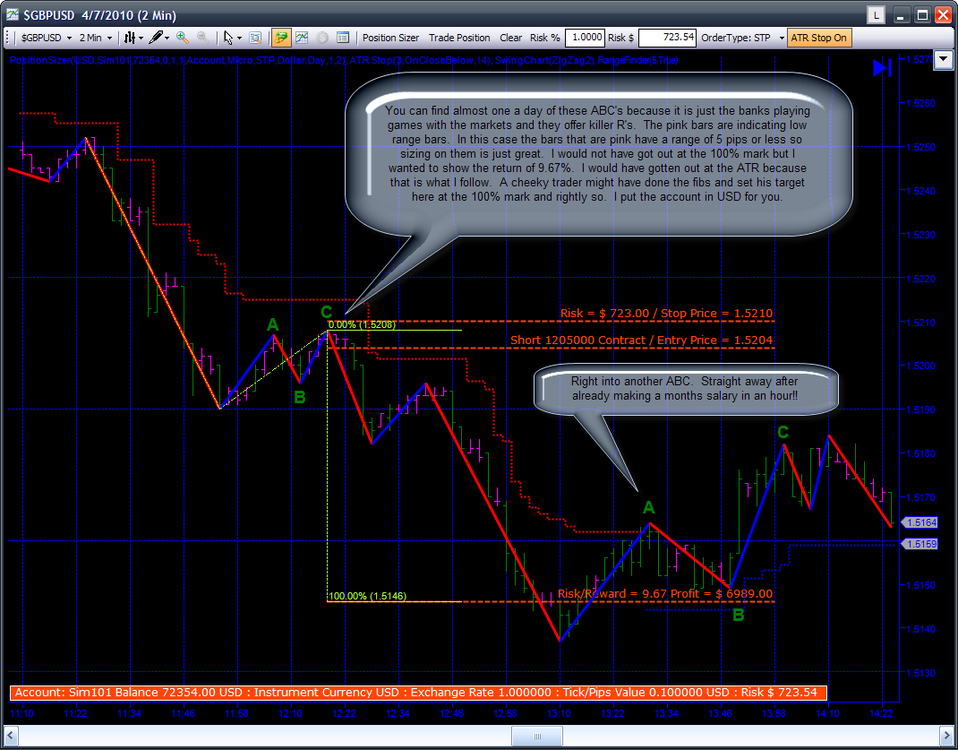
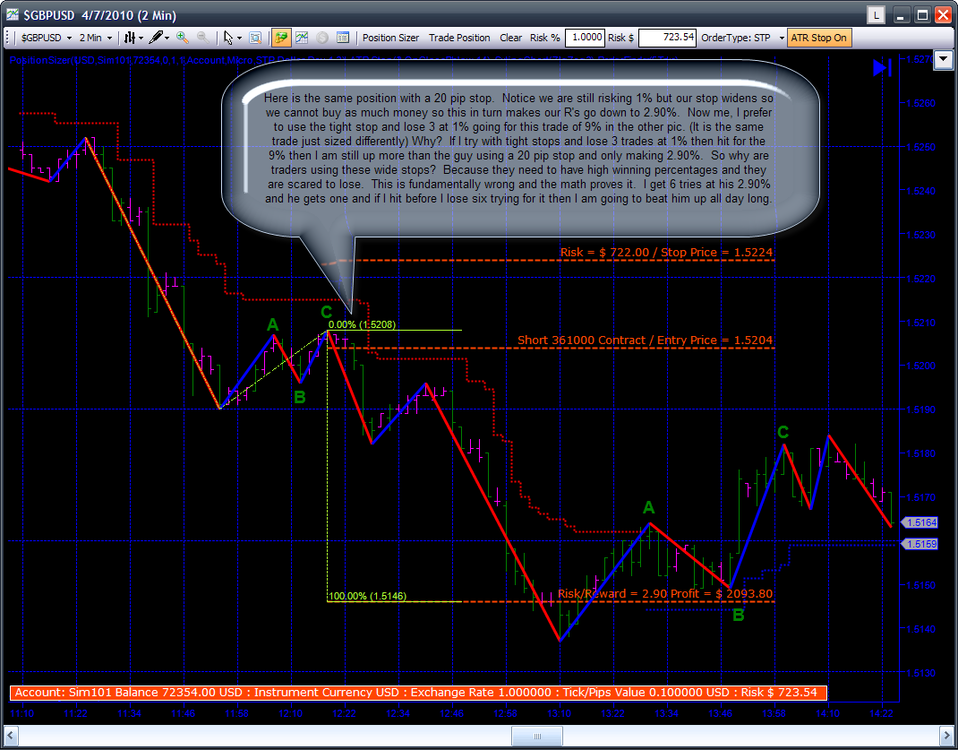
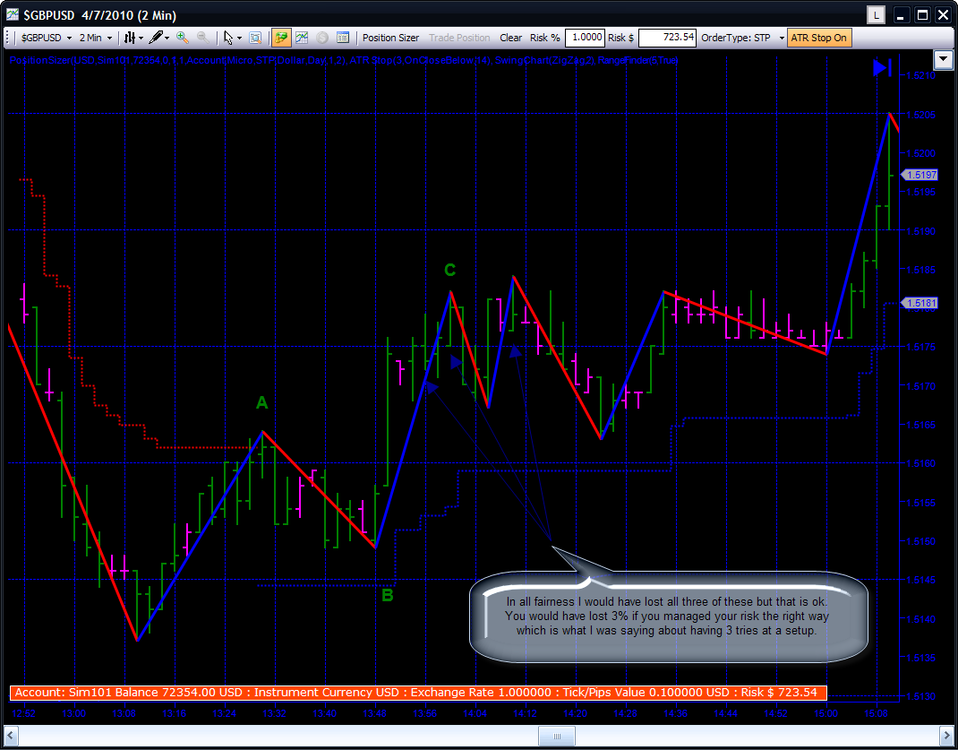
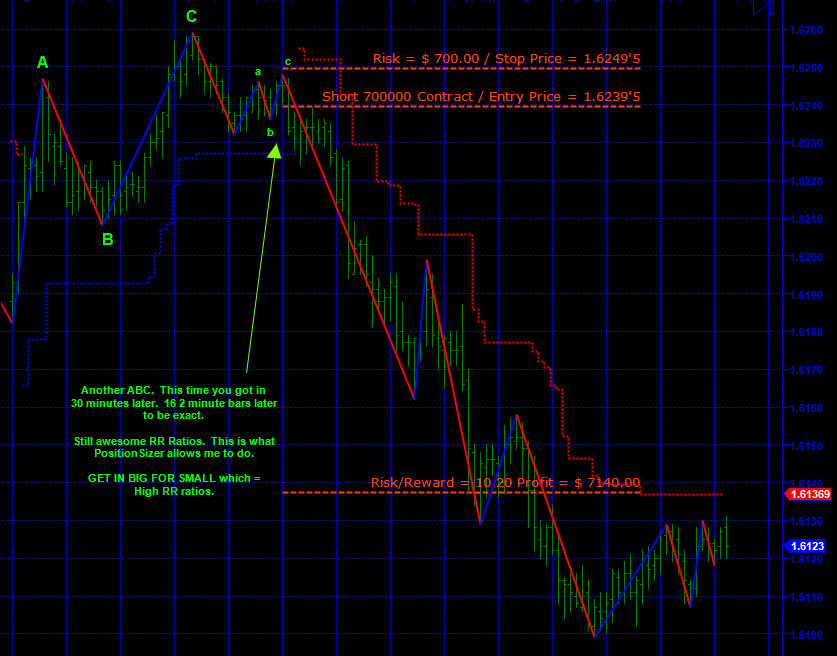
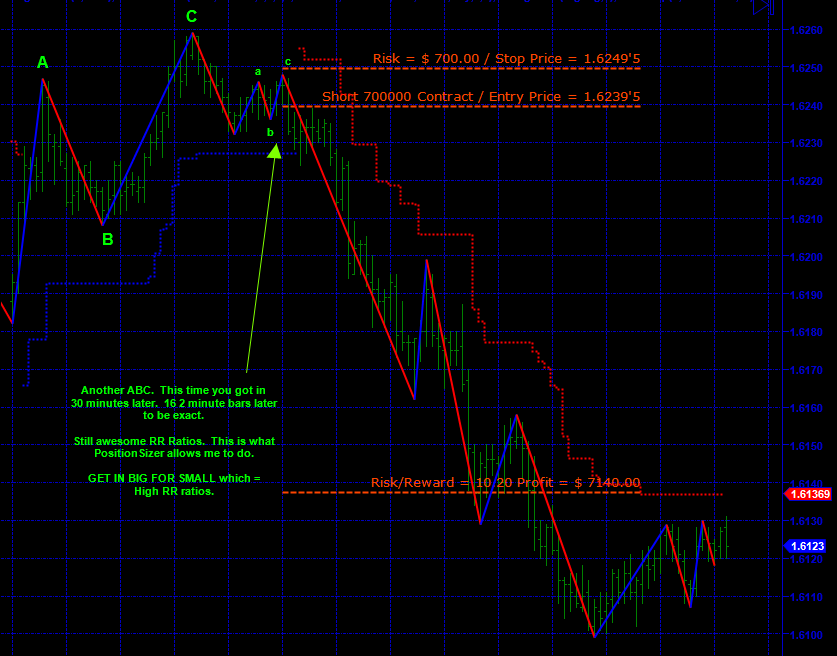
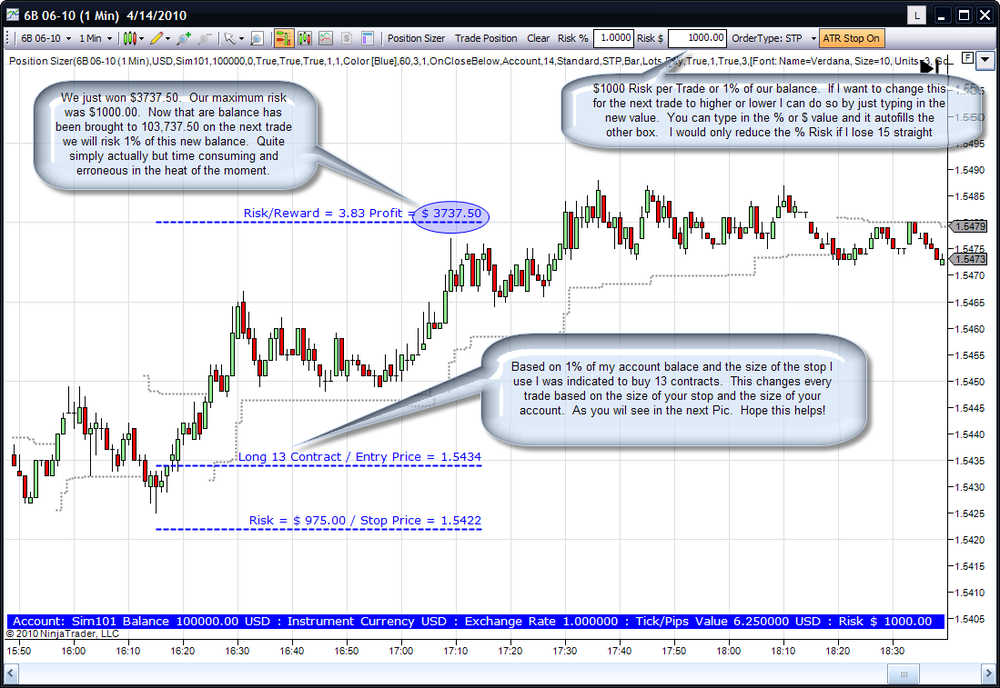
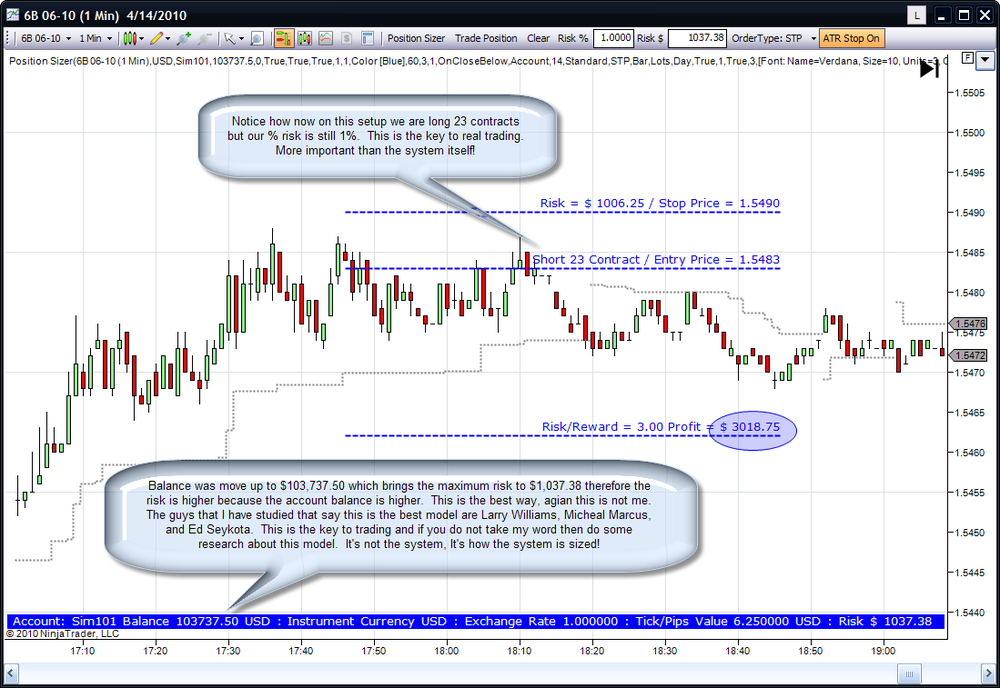
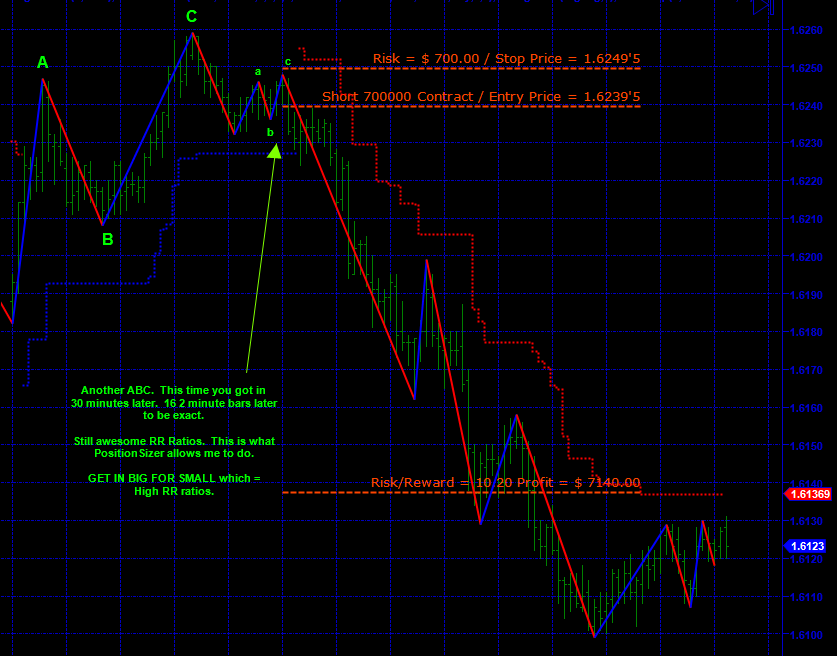
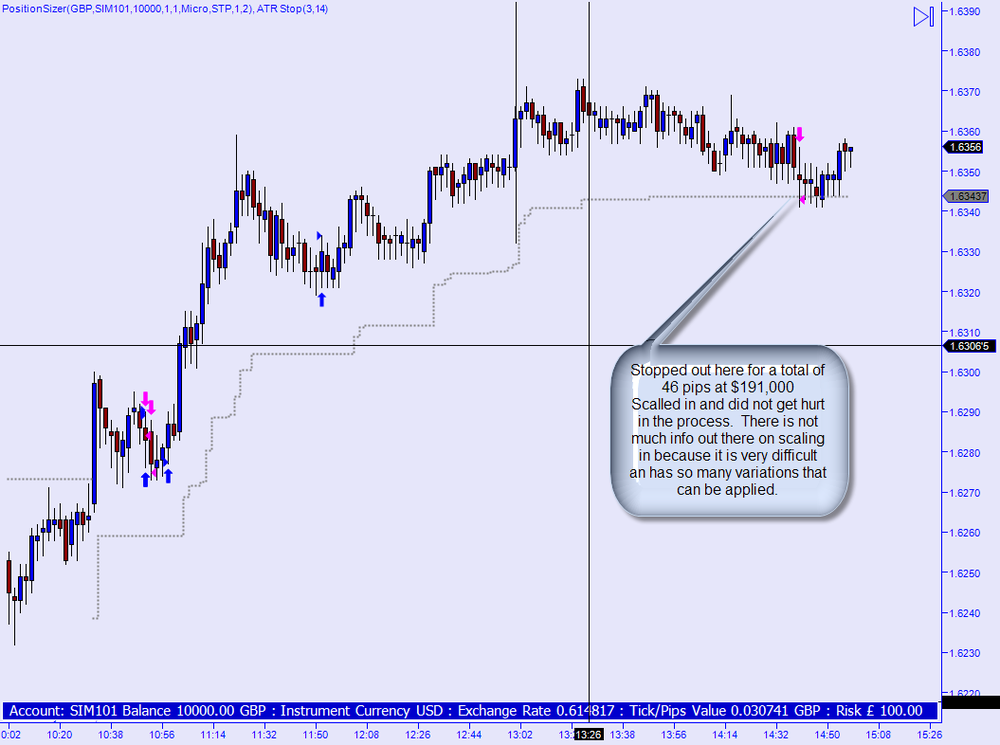
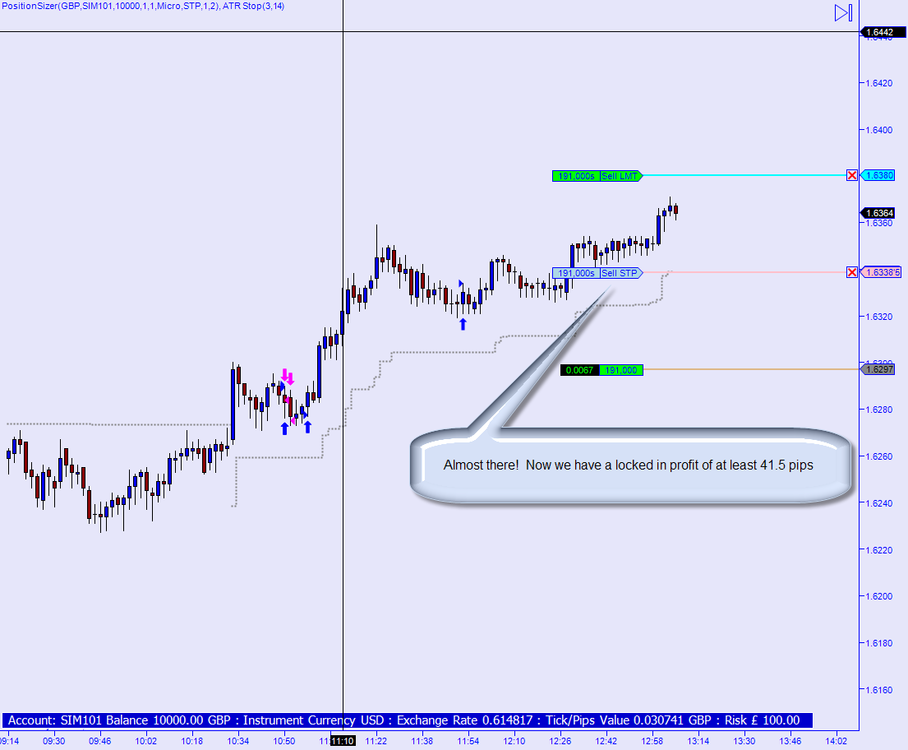
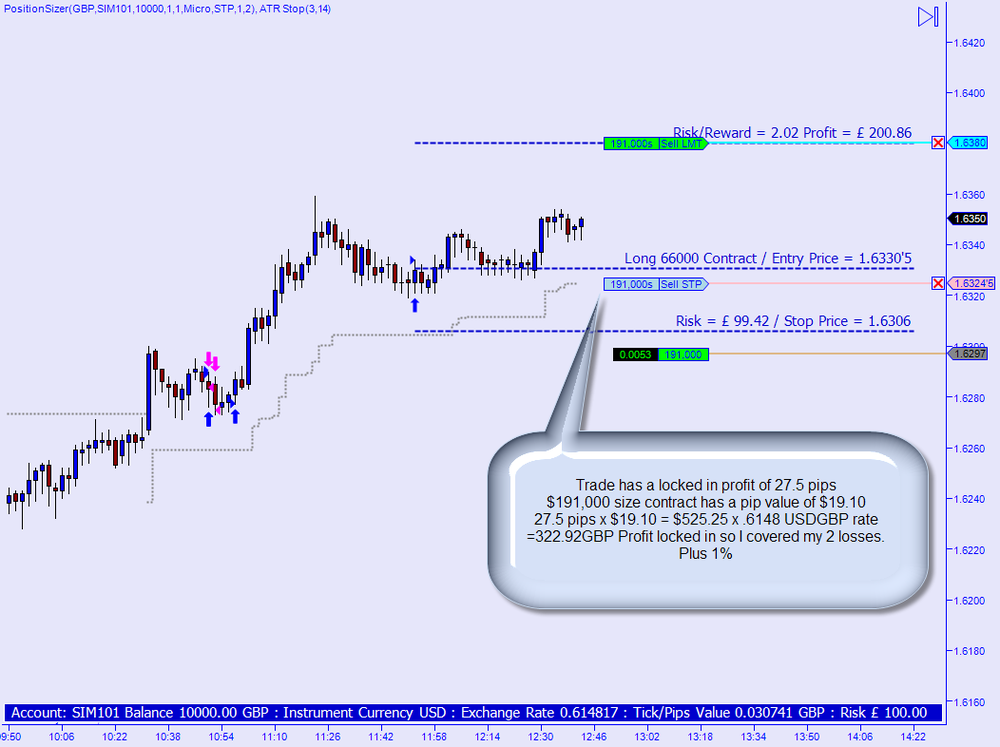
Position Sizing Software
in Risk & Money Management
Posted
First off it sounds like you have an agenda of some sort. I bought positionsizer for $595 on sale from $695. Not 900 as you state. Go right ahead and program if you can find someone to do it.
As well Find me an AUTOMATIC ATR that manages my stop order at the broker by moving the order up while I am in the bathroom or whatever. Please find it for me and post the site here. Everytime the ATR price line moves my stop order is changed at the broker. You really post nonsense my friend!!!
API Programming cost $300 an hour and not $100 an hour like normal programming. Just go to FXCM if you want or need to verify the coding prices. I said. "OK, pay $595 for an order entry add-on that gets my order sized and filled at the broker so I am in the trade in less that 5 seconds is worth $595 to me. Especially since API coding cost $300 an hour!"
So thanks for telling me I got ripped off even though I did not. Kind my friend, Just makes you look bitter. Sorry you cannot afford $595 or $695. This post was about risk management. Not how much I paid for my software and then telling me I got ripped off.
I am out of here. Forums suck. Too many idoits!
The Pip Thief